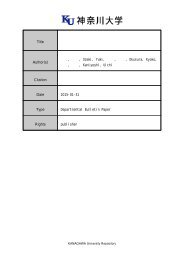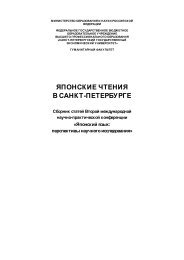to Learners with Special Educational Needs
e-textbook SEN
e-textbook SEN
You also want an ePaper? Increase the reach of your titles
YUMPU automatically turns print PDFs into web optimized ePapers that Google loves.
Pokrivčáková, S. et al. (2015). Teaching Foreign Languages <strong>to</strong> <strong>Learners</strong> <strong>with</strong> <strong>Special</strong> <strong>Educational</strong> <strong>Needs</strong>:<br />
e-textbook for foreign language teachers. Nitra: Constantine the Philosopher University. 128 p.<br />
ISBN 978-80-558-0941-0<br />
the sides of the classroom. “Please, if you said you were Sydney, go <strong>to</strong> the place of the classroom<br />
where you think Sydney is, I am Uluru and I am in the middle of the classroom” and the teacher<br />
goes <strong>to</strong> the middle of the classroom positioning himself/herself as Uluru saying, “I am Uluru, and<br />
I am in the middle of the classroom”, then waits for the pupils <strong>to</strong> go somewhere and <strong>to</strong> declare<br />
what place they are.<br />
4. Checking the map<br />
Then the teacher projects the map of Australia on the whiteboard so that the pupils can check<br />
if they were right and maybe change the position if they were wrong<br />
(https://elt.oup.com/feature/global/maps/?cc=cz&selLanguage=cs)<br />
Or the students can work <strong>with</strong> the map in their reader (appendix 1):<br />
5. After checking the map we will find out something about the beginnings of the<br />
continent and the original inhabitants, i.e. presenting the students <strong>with</strong> the picture of the<br />
Aborigines from the reader and asking the students what they know about the original<br />
inhabitants of Australia. After eliciting what the students know, the teacher will use the text in<br />
the reader for a note-taking dictation (the students have <strong>to</strong> write only notes and later they will<br />
be working in groups of 3 or 4 <strong>to</strong> reconstruct the text <strong>to</strong>gether). After having reconstructed the<br />
text they will check it on the whiteboard, the dyslexic learners will get a copy of the text not <strong>to</strong><br />
have <strong>to</strong> look up at the board and down at their writing as that is difficult for them, they can get<br />
extra time <strong>to</strong> check and rewrite the text at home (find the text in Appendix 2).<br />
The lying game<br />
The teacher chooses the activities done by the Aborigines in the Dreamtime (e.g. 1) travelled<br />
<strong>to</strong> different parts of their land; 2) they ate plants and and fruits; 3) they built houses made from<br />
branches and leaves; 4) They painted their bodies and sang, danced), the teacher and the students<br />
decide how <strong>to</strong> mime each of the sentences and then the teacher divides the classroom in<strong>to</strong> As<br />
and Bs. As have <strong>to</strong> mime the activity, Bs come <strong>to</strong> As asking “What are you doing?“ and As have <strong>to</strong><br />
lie (i.e. they have <strong>to</strong> say one of the 3 activities they are not doing at the moment) and Bs start <strong>to</strong><br />
do the activity As said; then As go <strong>to</strong> another B asking “What are you doing?“ (the teacher lets<br />
them swap the roles several times <strong>to</strong> practive the sentences).<br />
6. Teacher-in-role<br />
The teacher divides the class in<strong>to</strong> groups of 4 <strong>to</strong> represent different tribes of Aborigines, then<br />
the teacher comes in the role of the main chief of all the tribes in Australia saying:<br />
My fellow Aborigines, this is how we were living here in the Dreamtime, travelling <strong>to</strong> different<br />
parts of the land, eating plants and fruits, building houses from branches and leaves, painting our<br />
bodies, singing and dancing, HOWEVER, this year: 1788, there are 11 ships approaching our land<br />
<strong>with</strong> many British immigrants who will change our lives forever. Each tribe, please, discuss, the<br />
possibilities what we can do <strong>with</strong> the bloody British, the n we will have a meeting at our sacred<br />
place, Uluru and we will <strong>to</strong>gether decide what we will do.<br />
Before the meeting the teacher projects the picture of Uluru on the whiteboard/wall<br />
(appendix 4):<br />
Then the meeting starts and the tribes (groups of students suggest what <strong>to</strong> do <strong>with</strong> the<br />
immigrants, e.g. welcome them, send them back home, etc.)<br />
After the meeting and the discussion has finished the teacher tells the students what<br />
happened and how the British changed the life in Australia, demonstrating the situation of<br />
Aborigines on how many lived in Tasmania (letting them guess the numbers):<br />
In 1804 (4000-6000 Aborigines)<br />
In 1831 (190 Aborigines)<br />
In 1876 (0 Aborigines)<br />
105






